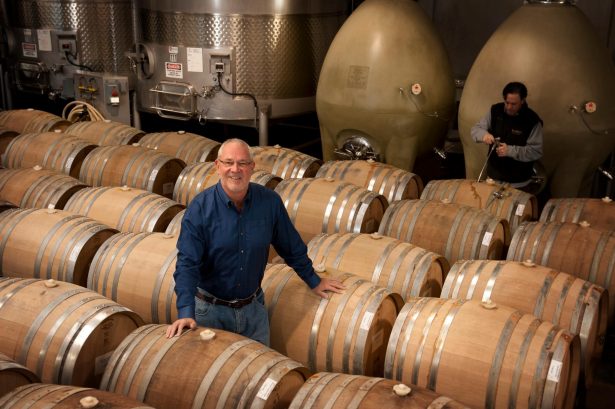I first met David Ramey in 1992, when he was in charge of the cellar at Chalk Hill. He was obviously a winemaker of great talent, and just as clearly his future was going to be brilliant. That’s pretty much the way things turned out. After successful stints at Matanzas Creek, Dominus and Rudd, he founded Ramey Wine Cellars in 1996.
At Ramey Wine Cellars, David’s approach has been serious in the extreme. He works with fruit from some of the best vineyard sites in California, including Hudson and Hyde. He has won more awards than anyone can count. He is the author of numerous hyper-technical papers on specific winemaking topics. He is committed to “the marriage of Old World methods with New World innovations.”
No wonder that he started Sidebar Cellars in 2015, as a way “to have some fun and a little instant gratification while waiting for our Ramey bottlings to mature.” This project has been incorrectly reported as a second label, which it is not. There is little vineyard overlap between Sidebar and Ramey Wine Cellars, and not much varietal similarity either. There’s no Chardonnay or Cabernet Sauvignon here, nor are the Sidebar wines made from declassified fruit from the Ramey vineyards.
Instead, we have California’s only version of Kerner, a German cross between Riesling and Trollinger. The 2016 ($25) reveals floral notes and aromas of melon and white pepper on the nose. The wine makes a vivid palate imprint, with suggestions of passion fruit tempered by pepper and spice. It will wake you up and energize you—and if you don’t have any oysters handy, it will inspire you to search for some.
The two Sauvignon Blancs are a study in contrasts. The 2015 High Valley ($16) is elegant and composed, with flavors of lemon, lime and grapefruit highlighted by good acidity. The 2015 Ritchie Vineyard ($35) is nearly explosive: vibrant and edgy, displaying citrus flavors and ripe melon notes. Both are good alternatives to the nearly ubiquitous New Zealand version of the grape. The 2016 Rosé ($20), made from old-vine Syrah, is crisp and structured, with tart notes of red currants and flavors of red cherries.
Black plum, raspberry jam and bramble are prominent on the nose of Sidebar’s 2015 Red Field Blend ($28). The fruit was sourced from a heritage vineyard in Russian River, an echo of Sonoma’s past. The wine is medium to full-bodied in the mouth, with ripe black fruit flavors, mature tannins and a nice spicy edge. Like the rest of the Sidebar wines, it has a firm palate imprint without being heavy or fat. You can almost taste the dust here, and the wine cries out for barbecue.
The Sidebar wines are interesting, delightful and a pleasure to drink. The common denominator is energy and verve. These are wines worth seeking out.
Mark Spivak is the author of Iconic Spirits: An Intoxicating History (Lyons Press, 2012) and Moonshine Nation (Lyons Press, 2014); his first novel, Friend of the Devil, is now available from Black Opal Books. For more information, go to amazon.com.
The post Sidebar Cellars appeared first on Palm Beach Illustrated.

